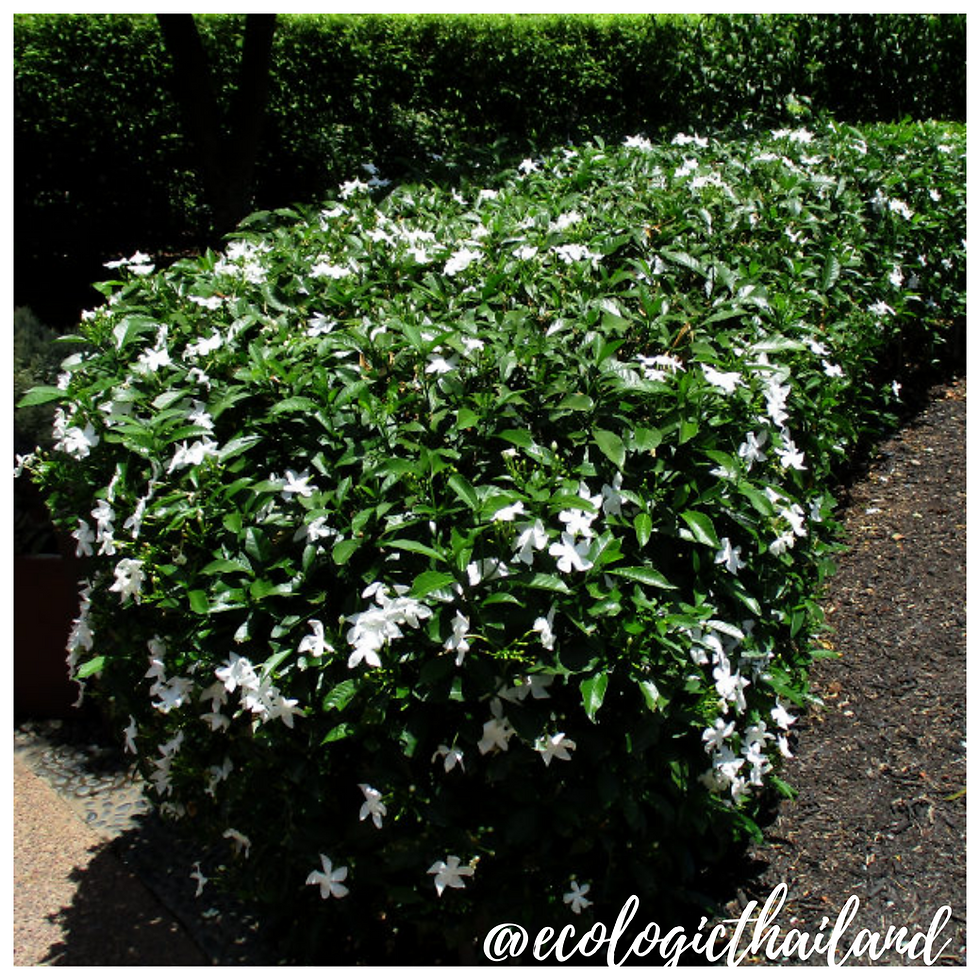Robusta Coffee
- Eco-Logic Resort
- Dec 7, 2020
- 3 min read
Thon Kaffeh | ต้นกาแฟ | Coffea canephora
Family: Rubiaceae - Genus: Coffea

Coffeeplants can be found in the Food Forest of the Thai Child Development Foundation and in the area of Eco-Logic's Restaurant.
Thailand is one of the top coffee producers in the world. The country is ranked third among the coffee producing countries of Asia with robusta coffee accounting for 99 percent of its production.
Robusta coffeeis grown in the provinces of Chumphon, Surat Thani, Nakhon Si Thammarat, Krabi, Phang Nga, and Ranong. One-quarter of the robusta coffee is for domestic consumption in the form of soluble, roasted, powdered, and tinned coffee.
Robusta coffee, is a flowering plant. The plant has a shallow root system and grows as a robust tree or shrub to about 10 meter tall. It flowers irregularly, taking about 10–11 months for cherries to ripen, producing oval-shaped beans.
The robusta plant has a greater crop yield than that of arabica, contains more caffeine (2.7% compared to arabica's 1.5%), and contains less sugar (3–7% compared to arabica's 6–9%).
Coffee is harvested in the dry season (December to May). You can find the coffee drying alongside the roads in Paksong during harvest season.

THE TREE
Robusta coffee is a very variable evergreen shrub or small robust tree growing up to 12 meters tall, though usually smaller. It often has a large, umbrella shaped growth habit. The plant is often found growing in open or dense rain-forest, forest margins and to desert areas.

THE LEAVES
The leaves of the coffee plant are waxy and dark green, elliptic, oblong, 15-30 cm long and 6-12 cm wide,
The leaves can be made into a drink, after they have been dried in the sun before being slightly toasted, a similar process in the making of some green tea.

THE FLOWERS
The flowers of coffee have a sweet, desirable fragrance during rainy season.
Flowers are white to pink.
Dried coffee flowers can be made into a tea.

THE FRUIT
The round berries are 1.0-1.2 cm across, smooth when dry and are hairless. Fruits are initially green turning to bright red as they mature.
Coffee berries can be eaten, some say it tastes sweet like mango or watermelon and fragrant like jasmine, hibiscus or rosewater. Or everything at the same time. The taste is delicate and fleeting but the texture is slimy.
CULINARY USE
Robusta coffee is coffee made from beans and has a low acidity and high bitterness. Robusta coffee is used primarily in instant coffee, espresso, and as a filler in ground coffee blends.
Roasted robusta beans produce a strong, full-bodied coffee with a distinctive earthy flavour, but usually with more bitterness than arabica. Since arabica beans are believed to have smoother taste with more acidity and a richer flavour, they are often considered superior, while the harsher robusta beans are mostly used as a filler in lower-grade coffee blends. However, the powerful flavour can be desirable in a blend to give it perceived "strength" and "finish", noticeably in Italian coffee culture.
At our Food Forest Kitchen Restaurant we serve local, handpicked, handroasted Robusta coffee from Paksong.
NUTRITION
It contains Caffeine. Excess use of Caffeine may cause nausea, vomiting, Insomnia, Nervousness, increased heartbeat.
TRADITIONAL MEDICINAL USE
NOTE: please take advice from a doctor if you are planning to use herbal medicine.
The seed contains caffeine, a widely used stimulant that is also used in proprietary painkillers to potentiate the effect of aspirin and paracetamol.
It also contains the stimulants theobromine and theophylline, as well as chlorogenic acid, which is stimulant and diuretic as well as a known allergen.
The seed is a bitter, aromatic, stimulant herb that has diuretic effects and controls vomiting.
It is reported to be analgesic, an aphrodisiac, anorexic, antidotal, cardiotonic, CNS-stimulant, counterirritant, diuretic, hypnotic, galactagogue and nervine.
Whilst not usually recognized as a medical herb, coffee is a highly effective general stimulant, having a particular effect upon the central nervous system, improving perception and physical performance.
It has been found of help in some cases of headache or migraine.
An enema made using coffee beans is an effective cleanser for the large bowel.
Coffee is a folk remedy for asthma, atropine poisoning, fever, flu, headache, jaundice, malaria, migraine, narcosis, nephrosis, opium poisoning, sores and vertigo.
INTO THE WILD: a down to earth experience

For guests and visitors to Paksong we organize weekly tours "The Edible Forest" and Foraging weekends: Into the Wild. We work with local guides to take you in the jungle of Paksong. After foraging, we will cook a meal with the ingredients, using bamboo together with you!
Come and join and learn about the abundance of food that nature gives us!
INTO THE WILD!


















Comments